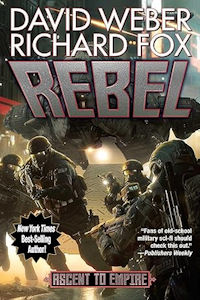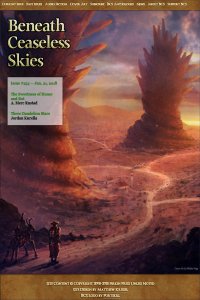Rebel by David Weber & Richard Fox: Review by Paul Di Filippo
 Rebel, David Weber & Richard Fox (Baen 978-1982193607, hardcover, 496pp, $28.00) September 2024
Rebel, David Weber & Richard Fox (Baen 978-1982193607, hardcover, 496pp, $28.00) September 2024
I seem to be on a bit of a quest lately to try to acquaint myself with authors I’ve shamefully overlooked. That’s always a healthy move, I think—aligned with, but distinct from, keeping up with brand-new debut writers. I reviewed a Michael Flynn book for the first time recently in these pages (alas, only after he had passed), and a couple of years ago I tackled the famed Richard Powers, with whom I had but a glancing familiarity.
Today’s “project”—if such a layer of intention can be added unobtrusively to a simple review—is David Weber. Here’s a giant of the field, with nearly a hundred books to his name, who’s been around since 1990—a mere thirty-four years during which I have not sampled him. Well, as usual in such cases, that omission hurts only me, since, judging from his two recent books, the kickoff to a series titled Ascent to Empire, he offers solid speculation, moral conundrums, tangible characterizations, and slambang thrills. What SF reader would not go for that catalogue of virtues?
Before proceeding, we need to be careful not to overlook that both of these books feature a co-author, Richard Fox—also unknown to me. Checking out Fox’s not-unrespectable canon, which includes a Dragon Award-winning title, I note that the themes of his books seem to resonate with Weber’s, making him a natural match-up. However, with his much lower profile in the SF hierarchy, I am bound to assume that Fox is the junior partner in this enterprise, and that the majority of the shape and heft of this series can be laid at Weber’s door. (Never before having read Weber, though, I say this without the ability to prove it!) But since the prose is utterly and organically whole, and since the plotting shows no weird jinking up and down, I am going to award Fox full kudos for whatever unrevealed share of the two books is his. All my praise and small quibbles are on his shoulders as well as on Weber’s.
Enough critical folderol. Where are we? Well, we are in the 2600s, and humanity has attained the stars. Mankind has sorted itself into two warring camps: the Federation, and the League, of roughly equal capabilities. Thanks to the vagaries of colonization, the League is majority Asian, while the Federation is more heterogenous. The Federation is ostensibly a democracy, the League less so. They have been battling for nearly sixty years, and are currently at a stalemate. Additionally, one alien species has been contacted, the Rish, who have their own Sphere of activity. The Rish have proclaimed their neutrality.
All this is conveyed in a very compact and readable Future History that leads off the second book in the series, Rebel. I would have liked to see it included in the paperback edition of the first book, Governor, where it would have helped me get my bearings. But even without, the reader soon picks up the scenario.
Our main POV will be distributed among citizens of the Federation, although we will certainly get up-close and personal with Leaguers as well. Our hero is one Terence Murphy. An older fellow, initially part of the noncombat Survey Force, Murphy is also, through marriage to one Simron Kadare, a member of the Five Hundred, the elite rulers and nobility of the Federation. Centuries of dominance and self-serving traditions have turned many in the Five Hundred rotten, out for themselves, not the good of the Federation. This certainly irks Murphy, but he is not a troublemaker—yet.
But then he is given Admiral status, assigned to a battleship, and sent to one of the Fringe Worlds to rule as governor, a kind of hapless sinecure. The Fringe worlds are the most mistreated part of the Federation. His soldier son Callum, one of his three kids, accompanies him. There, Murphy discovers the depths of mistreatment that the Fringe worlds have been undergoing for decades. He also learns that the Rish are not neutral, but secretly allied with the League. He also proves to have inherited his famous ancestor’s martial abilities, showing himself a master strategist and tactician. Events force his hand as he tries to right wrongs, he goes rogue, and the Free Worlds Alliance is born. Thus ends Governor.
I have scanted so much in this synopsis. There are scores of lively characters, all living out their own subplots. One of the most significant is a young slave girl discovered on a world previously smashed by the Federation. Her name is Eira, and after she enlists, she is assigned as a bodyguard to Callum Murphy. Do I see a romance blooming? My lips are sealed.
Governor is replete with plenty of action sequences that approach Doc Smith proportions and ferocity, all conveyed in crystal clear prose. But what surprised me about Weber’s approach is how discursive—in the sense of talk-heavy—the book is. There are chapters aplenty in which folks discuss the nature of their friends and enemies; what’s happened or is about to happen; the philosophy of governing; battle plans A through Z; the odds of winning or losing, etc. None of this talk is boring or unnecessary, and Weber (and Fox) have a great way with both elegant speeches and grunt-level foulmouthedness. But one of my preconceptions about the space military genre was that the ratio of action to talk would be the reverse of what it is here. It seems to me that perhaps C. J. Cherryh’s later books contributed to this mode.
Rebel opens right on the tail of its predecessor. We know most of the cast already, but will meet many new folks. One prominent figure is Vice Admiral Rajenda Thakore, Murphy’s brother-in-law. (Visiting Thakore on Earth allows us to hook up again with Simron. She was introduced charmingly in the first book, but then necessarily shunted offstage. It’s good to have her back.) Thakore is tasked with taking a big fleet out to the Fringe to subdue or convince or even kill Murphy.
Meanwhile, revolt has spread to another Fringe system, the Bellerophon sector. A new large and enticing cast is brought onstage here. Murphy finds he cannot be everywhere at once, and so this underpowered planet is left to face alone a punitive visit from the Federation. This force is led by one General Taskin Alaimo, who was previously responsible for a mass slaughter on an earlier rebel planet, Gobelins. And he is perfectly happy to enact the same punishment here. Alaimo provides one thing the book had been missing till now: a Big Bad. Alaimo makes Darth Vader look like General MacArthur, and his long march and eventual comeuppance prove very satisfying.
Weber and Fox hew strictly to physics (except of course for FTL travel) and get a lot of plot points out of STL communications lags. Their version of starship troopers—the Hoplons—is wickedly nasty. And they limn the dictates of political chicanery and responsibility well.
And then of course we get to geek out at sections like this:
The outgoing waves of TF 804’s missiles stippled the plot, but the glaring red icons of Terrence Murphy’s missiles charged onward, coasting for 6.7 minutes. And then, at 5,926,950 kilo-meters, they engaged their own drives and came shrieking in at a final closing velocity of 100,000 KPS.
Counter-missiles streamed to meet them, but the solutions were late and hurried, because no one had anticipated the threat, and the attack wave was liberally seeded with Fallax EW missiles and Phalanx escort missiles. They cut through the froth of counter-missiles, drove into the teeth of the point defense lasers and autocannon. At that closing velocity, with the full endurance of their Hauptman coils for terminal attack maneuvers, the close-in defenses had time for only a single shot each, and well over eight thousand Bijalees broke through everything the task force could throw at it.
A shroud of nuclear detonations wrapped itself around TF 804 as 8,265 laser heads spawned 49,590 bomb-pumped lasers.
The series does not end with Rebel, of course. So if you’re looking for a meaty saga of space warfare that provides action and characterization and thrills in equal measures, you’d best dig in now, before Volume Three appears.
Interested in this title? Your purchase through the links below brings us a small amount of affiliate income and helps us keep doing all the reviews you love to read!
 While you are here, please take a moment to support Locus with a one-time or recurring donation. We rely on reader donations to keep the magazine and site going, and would like to keep the site paywall free, but WE NEED YOUR FINANCIAL SUPPORT to continue quality coverage of the science fiction and fantasy field.
While you are here, please take a moment to support Locus with a one-time or recurring donation. We rely on reader donations to keep the magazine and site going, and would like to keep the site paywall free, but WE NEED YOUR FINANCIAL SUPPORT to continue quality coverage of the science fiction and fantasy field.
©Locus Magazine. Copyrighted material may not be republished without permission of LSFF.









Hi,
Thanks for your review. Has anybody else noticed that all the dates at the beginning of the Chapters are 100 years wrong? They should be 2655 not 2555 as printed. I have e-mailed BAEN but so far….crickets. I imagine this is a super-embarrassing mistake worthy of a yellow-sheet publisher. What do you think?
Best,
WK